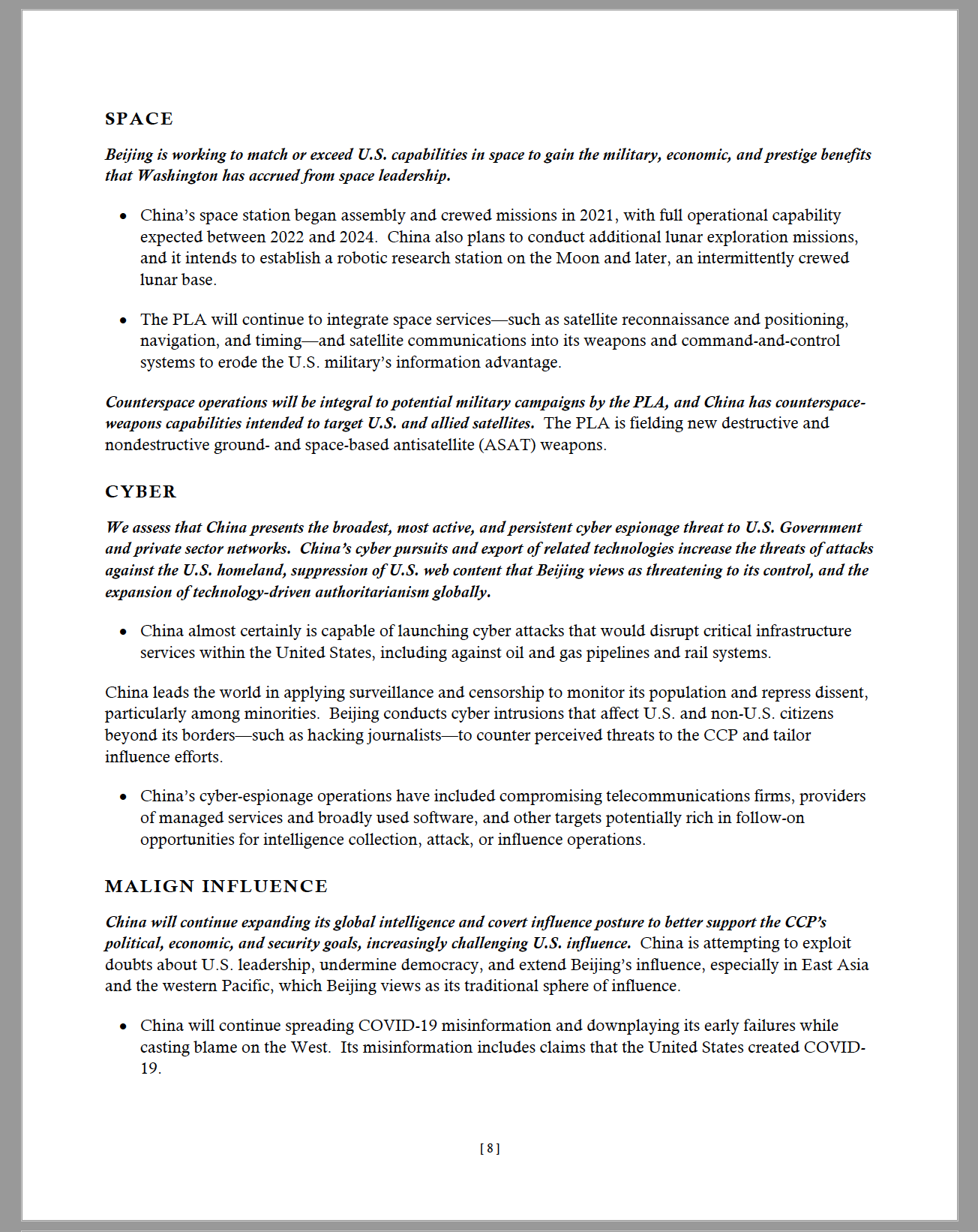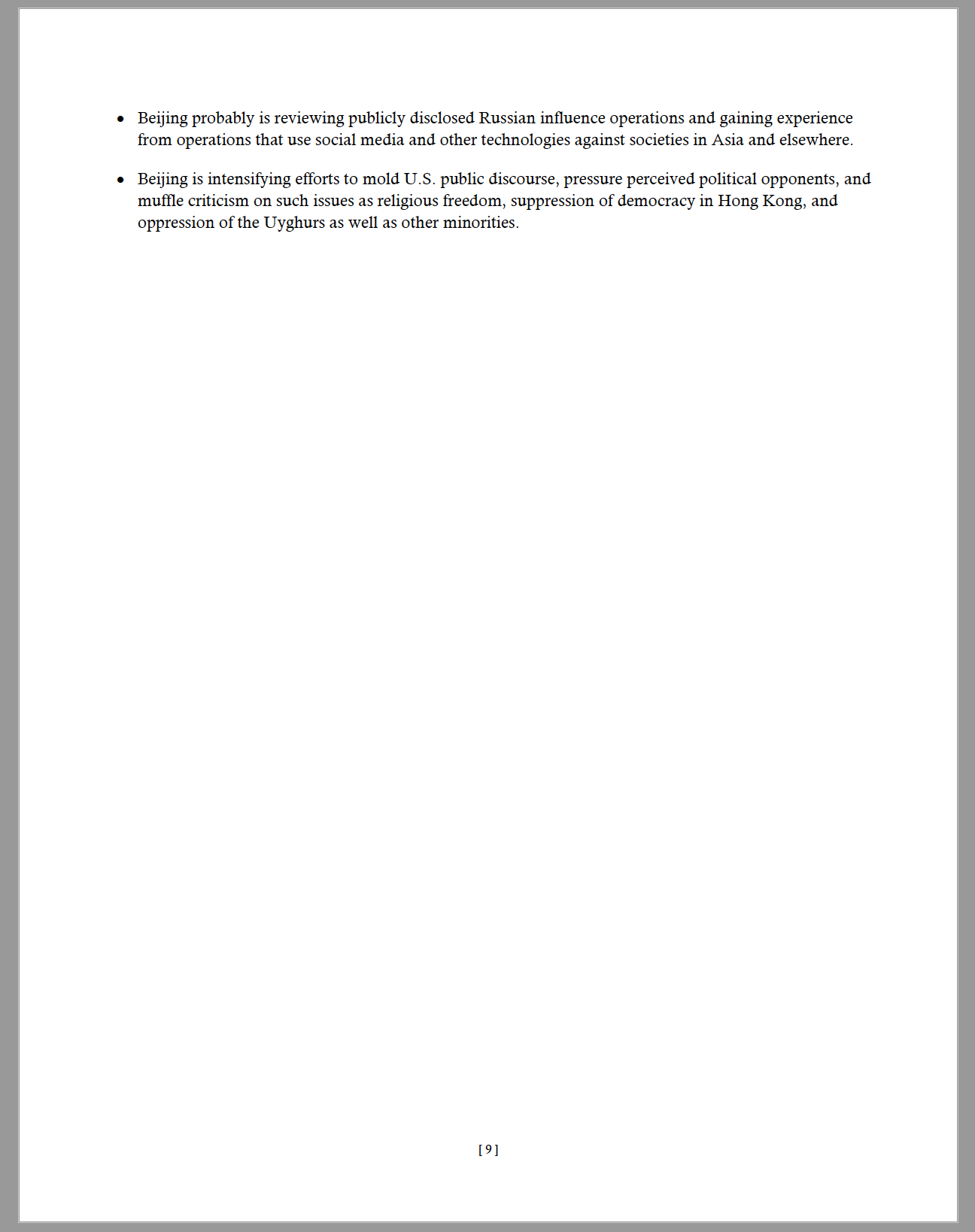Annual Threat Assessment of the U.S. Intelligence Community—Key China Content
Annual Threat Assessment of the U.S. Intelligence Community (McLean, VA: Office of the Director of National Intelligence, February 2022). [with information as of January 2022]
PRC-specific content, pp. 6–9:
CHINA
REGIONAL AND GLOBAL OBJECTIVES AND ACTIVITIES
The Chinese Communist Party (CCP) will continue efforts to achieve President’s Xi Jinping’s vision of making China the preeminent power in East Asia and a major power on the world stage. The CCP will work to press Taiwan on unification, undercut U.S. influence, drive wedges between Washington and its partners, and foster some norms that favor its authoritarian system. China’s leaders probably will, however, seek opportunities to reduce tensions with Washington when it suits their interests. China will maintain its statist economic policies because China’s leaders see state direction as necessary to reduce dependence on foreign technologies, enable military modernization, and sustain growth—ensuring CCP rule and the realization of its vision for national rejuvenation.
- Beijing sees increasingly competitive U.S.–China relations as part of an epochal geopolitical shift and views Washington’s diplomatic, economic, and military measures against Beijing as part of a broader U.S. effort to prevent China’s rise and undermine CCP rule.
- The CCP is increasing its criticism of perceived U.S. failures and hypocrisy, including the U.S. withdrawal from Afghanistan and racial tensions in the United States.
- Beijing is increasingly combining growing military power with its economic, technological, and diplomatic clout to strengthen CCP rule, secure what it views as its sovereign territory and regional preeminence, and pursue global influence.
- However, China faces myriad—and in some cases growing—domestic and international challenges that probably will hinder CCP leaders’ ambitions. These include an aging population, high levels of corporate debt, economic inequality, and growing resistance to China’s heavy-handed tactics in Taiwan and other countries.
China uses coordinated, whole-of-government tools to demonstrate strength and compel neighbors to acquiesce to Beijing’s preferences, including its territorial and maritime claims and assertions of sovereignty over Taiwan.
- Beijing will press Taiwan to move toward unification and will react to what it views as increased U.S.–Taiwan engagement. We expect that friction will grow as China continues to increase military activity around the island, and Taiwan’s leaders resist Beijing’s pressure for progress toward unification. China’s control over Taiwan probably would disrupt global supply chains for semiconductor chips because Taiwan dominates production.
- In the South China Sea, Beijing will continue to use growing numbers of air, naval, and maritime law enforcement platforms to intimidate rival claimants and signal that China has effective control over contested areas. China is similarly pressuring Japan over contested areas in the East China Sea.
Beijing will continue to promote the Belt and Road Initiative (BRI) to expand China’s economic, political, and military presence abroad. Beijing will adjust its approach to BRI in response to publicity and sustainability challenges, and diversify project selection in an attempt to improve the initiative’s brand and minimize international criticism. China also will promote new international norms for technology and human rights, emphasizing state sovereignty and political stability over individual rights. It will continue to erode the vestiges of freedom in Hong Kong.
China will remain the top threat to U.S. technological competitiveness as Beijing targets key sectors and proprietary commercial and military technology from U.S. and allied companies and institutions. Beijing uses a variety of tools, from public investment to espionage to advance its technological capabilities. Beijing’s willingness to use espionage, subsidies, and trade policy to give its firms a competitive advantage represents not just an ongoing challenge for the U.S. economy and its workers, but also advances Beijing’s ability to assume leadership of the world’s technological advancement and standards.
China will continue deepening diplomatic, defense, and technology cooperation with Russia to challenge the United States.
MILITARY CAPABILITIES
China will continue pursuing its goal of building a world-class military that will enable it to secure what it views as its sovereign territory, establish its preeminence in regional affairs, and project power globally while offsetting perceived U.S. military superiority.
- Beijing is accelerating the development of key capabilities it believes the People’s Liberation Army’s (PLA) needs to confront the United States in a large-scale, sustained conflict.
The PLA Navy and Air Force are the largest in the region and continue to field advanced platforms that improve China’s ability to establish air superiority and project power. The PLA Rocket Force’s (PLARF) short-, medium-, and intermediate-range conventional systems can hold U.S. forces and bases in the region at risk. In 2020, the PLARF fielded its first operational hypersonic weapons system, the DF-17 hypersonic glide vehicle-capable medium-range ballistic missile (MRBM), which could challenge U.S. missile defense systems.
We expect the PLA to continue to pursue the establishment of overseas military installations and access agreements to enhance its ability to project power and protect China’s interests abroad.
WMD
Beijing will continue the largest ever nuclear force expansion and arsenal diversification in its history. Beijing is not interested in agreements that restrict its plans and will not agree to negotiations that lock in U.S. or Russian advantages. China is building a larger and increasingly capable nuclear missile and bomber force that is more survivable, more diverse, and on higher alert than in the past, including nuclear missile systems designed to manage regional escalation and ensure an intercontinental strike capability in any scenario.
- China is building hundreds of new intercontinental ballistic missile (ICBM) silos.
- As of 2020, the People’s Liberation Army Air Force (PLAAF) had operationally fielded the nuclear-capable H-6N bomber, providing a platform for the air component of the PRC’s nascent nuclear triad.
- China conducted a hypersonic glide vehicle (HGV) flight test that flew completely around the world and impacted inside China.
SPACE
Beijing is working to match or exceed U.S. capabilities in space to gain the military, economic, and prestige benefits that Washington has accrued from space leadership.
- China’s space station began assembly and crewed missions in 2021, with full operational capability expected between 2022 and 2024. China also plans to conduct additional lunar exploration missions, and it intends to establish a robotic research station on the Moon and later, an intermittently crewed lunar base.
- The PLA will continue to integrate space services—such as satellite reconnaissance and positioning, navigation, and timing—and satellite communications into its weapons and command-and-control systems to erode the U.S. military’s information advantage.
Counterspace operations will be integral to potential military campaigns by the PLA, and China has counterspace-weapons capabilities intended to target U.S. and allied satellites. The PLA is fielding new destructive and nondestructive ground- and space-based antisatellite (ASAT) weapons.
CYBER
We assess that China presents the broadest, most active, and persistent cyber espionage threat to U.S. Government and private sector networks. China’s cyber pursuits and export of related technologies increase the threats of attacks against the U.S. homeland, suppression of U.S. web content that Beijing views as threatening to its control, and the expansion of technology-driven authoritarianism globally.
- China almost certainly is capable of launching cyber attacks that would disrupt critical infrastructure services within the United States, including against oil and gas pipelines and rail systems.
China leads the world in applying surveillance and censorship to monitor its population and repress dissent, particularly among minorities. Beijing conducts cyber intrusions that affect U.S. and non-U.S. citizens beyond its borders—such as hacking journalists—to counter perceived threats to the CCP and tailor influence efforts.
- China’s cyber-espionage operations have included compromising telecommunications firms, providers of managed services and broadly used software, and other targets potentially rich in follow-on opportunities for intelligence collection, attack, or influence operations.
MALIGN INFLUENCE
China will continue expanding its global intelligence and covert influence posture to better support the CCP’s political, economic, and security goals, increasingly challenging U.S. influence. China is attempting to exploit doubts about U.S. leadership, undermine democracy, and extend Beijing’s influence, especially in East Asia and the western Pacific, which Beijing views as its traditional sphere of influence.
- China will continue spreading COVID-19 misinformation and downplaying its early failures while casting blame on the West. Its misinformation includes claims that the United States created COVID-19.
- Beijing probably is reviewing publicly disclosed Russian influence operations and gaining experience from operations that use social media and other technologies against societies in Asia and elsewhere.
- Beijing is intensifying efforts to mold U.S. public discourse, pressure perceived political opponents, and muffle criticism on such issues as religious freedom, suppression of democracy in Hong Kong, and oppression of the Uyghurs as well as other minorities.










































